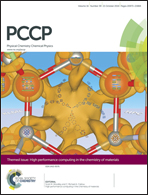Protein diffusion through charged nanopores with different radii at low ionic strength
Abstract
The diffusion of two similar molecular weight proteins, bovine serum albumin (BSA) and bovine haemoglobin (BHb), through nanoporous charged membranes with a wide range of pore radii is studied at low ionic strength. The effects of the solution pH and the membrane pore diameter on the pore permeability allow quantifying the electrostatic interaction between the charged pore and the protein. Because of the large screening Debye length, both surface and bulk diffusion occur simultaneously. By increasing the pore diameter, the permeability tends to the bulk self-diffusion coefficient for each protein. By decreasing the pore diameter, the charges on the pore surface electrostatically hinder the transport even at the isoelectric point of the protein. Surprisingly, even at pore sizes 100 times larger than the protein, the electrostatic hindrance still plays a major role in the transport. The experimental data are qualitatively explained using a two-region model for the membrane pore and approximated equations for the pH dependence of the protein and pore charges. The experimental and theoretical results should be useful for designing protein separation processes based on nanoporous charged membranes.


 Please wait while we load your content...
Please wait while we load your content...